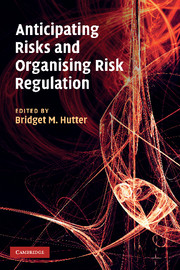Book contents
- Frontmatter
- Contents
- Contributors
- Preface
- Part I Introduction
- Part II Threat, vulnerabilities and insecurities
- 2 Risk society and financial risk
- 3 Before the sky falls down: a ‘constitutional dialogue’ over the depletion of internet addresses
- 4 Changing attitudes to risk? Managing myxomatosis in twentieth-century Britain
- 5 Public perceptions of risk and ‘compensation culture’ in the UK
- 6 Colonised by risk – the emergence of academic risks in British higher education
- Part III Social, organisational and regulatory sources of resilience and security
- References
- Author index
- Subject index
4 - Changing attitudes to risk? Managing myxomatosis in twentieth-century Britain
Published online by Cambridge University Press: 10 November 2010
- Frontmatter
- Contents
- Contributors
- Preface
- Part I Introduction
- Part II Threat, vulnerabilities and insecurities
- 2 Risk society and financial risk
- 3 Before the sky falls down: a ‘constitutional dialogue’ over the depletion of internet addresses
- 4 Changing attitudes to risk? Managing myxomatosis in twentieth-century Britain
- 5 Public perceptions of risk and ‘compensation culture’ in the UK
- 6 Colonised by risk – the emergence of academic risks in British higher education
- Part III Social, organisational and regulatory sources of resilience and security
- References
- Author index
- Subject index
Summary
Over the last twenty years or so social theorists such as Ulrich Beck and Anthony Giddens have developed the idea that contemporary or ‘late modern’ Western society can be characterised as a risk society (cf. Boin, Briault, Huber, Lloyd-Bostock, this volume). As such, it differs fundamentally from societies of earlier periods. For Giddens, people in a risk society ‘increasingly live on a high technological frontier which absolutely no one completely understands and which generates a diversity of possible futures’ (Giddens 1999a: 3). A risk society is not necessarily one in which, objectively, there are more dangers than in the past, but its emergence signifies two developments. First, risk is increasingly a manufactured product of human progress, especially developments in science and technology, rather than a supernatural or inexplicable phenomenon external to human endeavour. Often, these manufactured risks are connected with health and the natural environment; examples include climate change, BSE or mobile phone emissions. Second, risk becomes a central and sustained element of public debate, with accusations of scaremongering and cover-up abounding (Giddens 1999a: 3; Lupton 1999: 64–7). Hence, according to Beck, ‘Modern society has become a risk society in the sense that it is increasingly occupied with debating, preventing and managing risks that it itself has produced’ (Beck 2006: 332).
Much of this might seem of peripheral concern to historians.
- Type
- Chapter
- Information
- Anticipating Risks and Organising Risk Regulation , pp. 68 - 89Publisher: Cambridge University PressPrint publication year: 2010



